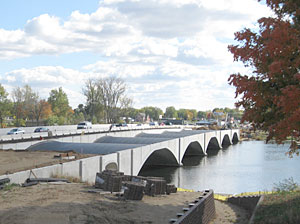2011 Keating Report on government budgets and spending

A lot of signs point to a stronger economy, including growing consumer confidence, higher sales at domestic car and truck makers, record-breaking corporate profits and higher tax revenues.
One expert who sees growing tax receipts is Steven Latin-Kasper, who is market data and research director at the Farmington Hills, Mich.-based National Truck Equipment Association. “The economy’s coming around at this point, and as incomes rise and as profits rise at companies, which is happening now, obviously the taxes they pay will rise as well. So state and local governments aren’t going to get back to their 2007 budget levels anytime soon, but they will have more to spend in 2011 than they did 2010,” says Latin-Kasper.

Things are looking up, adds Latin-Kasper. “Many local and even state governments are now starting to see the end of this current downturn in tax revenues, and I suspect by the third quarter 2011, that they will be able to start spending some money on trucks and equipment again. I don’t think it’ll happen real significantly, but I think we are finally past the bottom in terms of local and state government budgets for equipment.”
In 2011, government purchases of goods and services will reach $3.03 trillion, up from $2.99 trillion in 2010, according to Waltham, Mass.-based economic forecaster IHS Global Insight. State and local government purchases of goods and services will total $1.82 trillion in 2011.
Federal outlook
Federal purchases of goods and services will rise to $1.21 trillion in 2011, up slightly from $1.20 trillion in 2010, according to IHS Global Insight. Federal revenues, says the Congressional Budget Office (CBO), will rise to $2.6 trillion in 2011, up from $2.1 trillion in 2010. Download the projections of the CBO’s recent “The Budget and Economic Outlook: An Update,” from the CBO’s web site.
Some progress is being made on federal finances. According to IHS Global’s Chief U.S. Economist Nigel Gault, “the federal budget deficit narrowed slightly in fiscal 2010, to $1.3 trillion, from $1.4 trillion in 2009, and the fiscal 2011 deficit should be roughly the same. We are assuming no major stimulus initiatives and no major tax hikes.”
Down the road, however, the piper must be paid, says Gault. “Eventually, though, there must be both spending cuts and tax increases. The deficit is easily financed now, but that will not be the case indefinitely.”

In 2011, a big chunk of federal stimulus dollars will be spent, says Michael Balsam, an expert on government contracting and managing partner of Bear Pond Research.
“We are soon approaching the two-year anniversary of passage of the American Recovery and Reinvestment Act of 2009, known as the stimulus, yet just 40 percent of these funds have reached the contractors and subcontractors that perform the work,” Balsam told Govpro.com.
Balsam says that billions of dollars in stimulus project funding is still on its way — that about $120 billion remains unspent. Much of the remaining stimulus funding, says Balsam, “will go to economically valuable, longer-term infrastructure and clean-energy projects. We expect to see state and local government agencies award the majority of these remaining projects to private sector contractors sometime in 2011. However, the emphasis will shift from ‘shovel ready,’ which was a myth, to ‘job ready,’ meaning long-term private-sector jobs rather than temporary or public sector.”
Next: State government spending and budgets >
State government spending and budgets
State government budgets appear to be on the mend. According to the Denver- based National Conference of State Legislatures’ (NCSL) fiscal brief “Projected State Revenue Growth in FY 2011 and Beyond,” nearly every state forecast has fiscal year revenues exceeding last year’s, although many of the states note that revenues are still a good deal under peak levels. According to the brief, which was based on a survey of legislative fiscal directors, 40 states expect total tax collections in FY 2011 to be higher than they were in FY 2010.
“For the first time in a long time we’re seeing some slight improvement in the state revenue situation,” says Corina Eckl, NCSL’s fiscal program director. “But glimmers of improvement are tarnished by looming problems.”
State budget directors are concerned whether future state revenue growth will be sufficient to replace the loss of federal stimulus funds. Another potential problem for states is uncertainty whether Congress will extend the enhanced Federal Medical Assistance Payments rates that help states fund Medicaid programs.

States aren’t out of the woods yet, says Sujit CanagaRetna, a fiscal analyst for the Lexington, Ky.-based Council of State Governments (CSG). “Given the toxicity of raising taxes along with the no-tax pledges of many policymakers, the new legislative year will continue to see further reductions in state spending, including in the areas of education (K-12 and higher) and healthcare, the two largest items in state budgets.”
Governors and legislatures will hunt for budget solutions, CanagaRetna told Govpro.com: “States will continue to look to such strategies as public private partnerships, leasing and/or selling state assets, relinquishing their role in certain activities, taking on more debt and expanding gaming as they enact a Great Transformation, i.e., a fundamental reconfiguration of the relationship between state governments and citizens.”

States need to be realistic about their budgets, says Douglas Hall, who is director of the Economic Analysis and Research Network at the Washington-based Economic Policy Institute, a nonpartisan think tank. “Governors taking office in January should, by all means, strive to realize optimistic projections, but they also need to plan responsibly for less rosy contingencies.”
Hall isn’t overly optimistic about the future: “Most state governments face significant revenue shortfalls that continue to undermine economic recovery. Already, state and local governments have laid off hundreds of thousands of workers, with further cuts threatened. With state budget analysts predicting continued deficits through the remainder of FY2011, the following budget cycle, FY2012, promises to continue the pain.”
Next: Local government spending and budgets >
Local government spending and budgets
As 2011 gets underway, city finance directors have a few concerns, according to the National League of Cities’ (NLC) “2010 City Fiscal Conditions Survey,” which is a national mail survey of finance officers in U.S. cities.
The finance directors are concerned about underperforming real estate markets, lackluster consumer spending and unemployment. They are also worried that states will respond to falling revenues by further cutting their aid to local governments. Underfunded pension plans for municipal workers are also keeping city finance officials awake at night.
“Confronted with these issues, 80 percent of city finance officers forecast that their cities will be less able to meet needs in 2011 than they were in 2010,” the survey said.
How are cities dealing with prospective budget shortfalls in 2010? One of the most common ways, according to the finance directors surveyed, is to cut personnel (79 percent of responses to the NLC survey) or delay or cancel capital infrastructure projects (69 percent of responses). Over half (54 percent) of cities reported salary or wage reductions or freezes and one in three (35 percent) cities reported employee layoffs.
On the revenue side, the most common action taken to boost city revenues has been to increase the levels of fees for services. Two in five (40 percent) of the responding city finance officers reported that their community has taken this step. One in four cities increased the number of fees (23 percent) or increased the local property tax (23%).
The NLC 2010 fiscal survey questionnaire was mailed to a sample of 1,055 cities, including all cities with populations greater than 50,000, as well as a random sample of cities with populations between 10,000 and 50,000. The survey was conducted from April to June 2010. The 2010 survey drew responses from 338 responding cities, for a return rate of 32 percent.

Diminished property taxes are squeezing cities, says Elizabeth McNichol, a senior fellow at the Washington-based Center on Budget and Policy Priorities, a liberal-leaning think tank.
“The property tax is a really important revenue source to local governments, and the housing bubble has hit the base of the property tax very hard, so they are going to have a revenue problem,” says McNichol. “There’s a certain delay in the impact of the bubble on revenues, because local governments do their property tax assessments every year or two, so it takes a while for it to feed into the tax system. We’ll be feeling the full impact of that into 2011.”
McNichol told Govpro.com that it will be after 2012 before local governments see revenues approaching pre-recession levels.
Cities are working to maximize revenues. One example is the city of Alexandria, Va., which has partnered with the Silver Spring Md.-based Global Express firm to allow taxpayers to pay their personal property, real estate and other taxes in cash at the company’s 50 locations across Northern Virginia. The city saw an increase in the percentage of people paying in cash, and the agreement with Global Express gives taxpayers more options and convenience in settling their tax bills. In the past, residents had to pay their bills at city hall.
Local governments are contracting with not-for-profit groups like the Denver-based Center for Priority Based Budgeting to help with the budget process. Christianburg, Va., (2009 population, 19,638) recently approved an agreement to use the center’s services starting with fiscal year 2011-12.
“We have to find a new way to do our budget. The way we’ve been doing it is not going to work,” said Christianburg’s finance director, Val Tweedie when the deal was announced. Contracting with the company would allow for a “healthier” budget process, Tweedie said.
The Center for Priority Based Budgeting consults with governing bodies to assess departments, goals and needs in relation to spending, while helping establish a budget process that works best for the municipality.
The firm uses a detailed scoring system for each department and prioritizes activities based on performance and need when considering the budget.
Tweedie noted that in the past the Christianburg government had enough money to go around.
With money tighter the past few years, the city has had to take a number of measures to cut costs. Some of the measures included freezing positions, hiring and salary freezes, workforce reductions and early retirement incentives.
Key points, said Tweedie, that the Christianburg government should emphasize going forward include: spending within its means, incorporating long-term planning and economic analysis, transparency, and establishing and maintaining reserve funds.
A priority-based budgeting approach may help governments cope with the new normal, says Jon Johnson, one of the founders of the Center for Priority Based Budgeting. “Cities and counties have little choice but to become leaner and focus their resources on those programs and services that are of the highest importance to their constituency,” Johnson told Govpro.com.

Empowering local governments might be the answer to reducing federal spending and chopping the federal deficit, according to Brian Riedl, who is a senior policy analyst at the Washington-based Heritage Foundation. “Congress should allow local governments, which are closer to the people, to creatively address local needs in areas such as transportation, justice, job training, and economic development,” says Riedl.
The Heritage Foundation analyst counts a total of $343 billion in available spending cuts for the new Congress to consider when it takes up the federal budget for FY 2012. Many of the cuts fall into six areas, including empowering local governments. The Heritage Foundation is a research institute that formulates and promotes conservative public policies.
Next: Public works and government construction spending >
Public works and government construction spending

Public construction is slowly getting back on track, says Jim Haughey, who is chief economist of Norcross, Ga.-based Reed Construction Data. “We expect public works construction and public spending in general will just about hold its own in 2011. It will probably be on the upturn by the end of 2011. The price of avoiding the recession in 2009 was having the bad news come in 2010 and 2011.”
Improving government budgets are the reason for the slight upturn, adds Haughey. “We’ll be dealing with new government budgets. The new federal budget starts in October and states generally start new budgets in July, and they won’t be as grim as the ones they worked with in 2010. State tax receipts have started going up, and the trend is moving in the right direction.”
The year 2012 promises additional growth in public construction activity, adds Haughey. “Funding problems will be cleared up by then, and a lot of projects will be designed and ready to go, waiting for the money. Public construction will grow as fast as the economy and probably a little better in 2012.”
In its “Construction Outlook 2011” report, New York-based McGraw-Hill Construction (MHC) estimates that the value of public works construction projects under way will drop 1 percent from 2010 levels. The value of public works construction should reach $122.3 billion in 2011.
Construction of government and institutional buildings and schools will match public works’ pace in 2010, with a slight drop from 2010 levels, according to MHC. One exception is healthcare facilities; the construction value of healthcare facilities in 2011 will be 9 percent higher than 2010 levels. The value of healthcare facilities construction should reach $22.9 billion in 2011, up from $21.0 billion in 2010.
For 2011, MHC forecasters predict: “While tax revenues are expected to show some improvement in 2011, continued deficit pressures will temper funding for public building construction at the state and local level. Hence another 6 percent decline to 30 million square feet is anticipated for 2011.”

Another public construction area that will show a slight decline is road building. The value of highway, street and bridge construction is expected to fall to $78.5 billion, compared to 2010’s estimated $82.2 billion level, says Alison Premo Black, senior economist at the Washington-based American Road & Transportation Builders Association (ARTBA).
What’s driving the 4.4 percent contraction in the national highway and bridge construction market in 2011? Continuing budget shortfalls for state and local governments, uncertainty surrounding a new long-term federal surface transportation bill, and reduced infrastructure investment under the stimulus law are some of the causes, says Premo Black.
She adds: “On a positive note, the amount of work completed on bridges is expected to increase to $25.4 billion in 2010. The value of real work in the bridge market has nearly doubled in the last decade as state and local governments have invested in this area to address deteriorating conditions.”

One bridge rehab underway is the County Road 17 bridge project over the St. Joseph River in Elkhart, Ind. Originally constructed in 1968, the bridge is a major north-south throughway. CONTECH Construction Products is providing a precast CON/SPAN bridge system with precast headwalls and wingwalls adjacent to five BEBO T series structures.
The paving on the bridge was completed on Nov. 17, 2010. Currently, five of the seven bridge lanes are open to traffic. Two lanes remain closed to facilitate construction of the Phase 2 portion of the sidewalk and bridge rail. The entire project is now ahead of schedule and is planned to be completed by Aug. 5, 2011.
In their “Construction Outlook 2011” report, MHC analysts predict a 1-percent uptick in environmental public works construction in 2011. The value of water resource projects, wastewater and drinking water facilities construction and hazardous waste remediation projects should reach $37.2 billion.
One environmental project underway is the conversion of the Val Vista Water Treatment Plant filtration system to granular activated carbon. The project, in Arizona’s Maricopa County, includes the construction of several new structures, including pump stations, a contactor building, ferrous chloride building, a diversion structure and electrical apparatus facility. The Phoenix-based Ninyo & Moore consulting firm will test engineered soils and asphalt at the site; observe, sample and test during placement of concrete and grout; perform visual welding inspections and deliver other services on the project.

Education construction won’t set any records in 2011, says Kenneth D. Simonson, chief economist at the Arlington, Va.-based Associated General Contractors of America. “The property tax receipts that fund a lot of public school projects, either directly or by paying off bonds, continue to shrink as house prices fall and more homeowners fall delinquent on taxes as well as mortgages.”
Continued government belt-tightening along with an important and timely boost in tax revenues may be enough to completely pull the economy out of its doldrums and ensure a good 2011 for all Americans, including government budget-watchers.
All levels of government, however, will need to get a grip on their spending, says the Heritage Foundation’s Brian Riedl. “At the state and local level, large deficits will require real spending restraint. States should not expect the federal funding train to continue providing bailout dollars, either.”
Michael Keating is senior editor for Govpro.com and Government Product News. He can be reached via e-mail at [email protected].
What do you think? Tell us in the comment box below.
Related Stories
- Keating Report on government budgets and spending, 2nd half 2010
- 2010 Keating Report on government budgets and spending
- Keating Report: Government Budgets & Spending Outlook, 2nd half 2009 (Part 1)
- Keating Report: Government Budgets & Spending Outlook, 2nd half 2009 (Part 2)
- 2009 Keating Report
- 2008 Keating Report




















